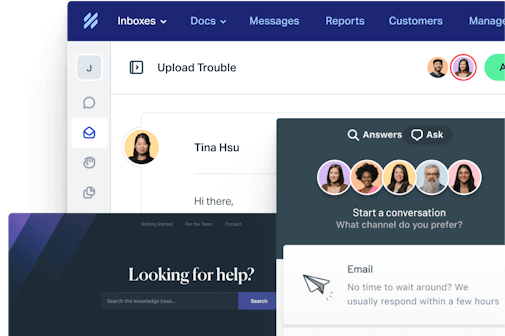As important as it is to consistently acquire customers, you'll never be able to retain them if they aren't satisfied. Customer satisfaction is a crucial metric when it comes to securing the future success of your business.
In this blog post, we'll break down customer satisfaction: what it is, how to measure it, how to improve it, and why it's vital to your brand.
What is customer satisfaction?
Customer satisfaction is a measurement that helps businesses understand how happy and satisfied customers are with their products, services, and/or functionalities.
Customer satisfaction is a crucial indicator of company health. If there are problems with your product or services, one of the first places you'll see it reflected is in your customer satisfaction score. Customer satisfaction has an impact on customer acquisition cost, a customer's time to value, and your customer retention numbers.
Beyond that, even if you have the most fantastic marketing team bringing in leads and the best sales team closing them, your customers won't stay if they don't feel valued.
How do you measure customer satisfaction?
The most common way that companies choose to measure customer satisfaction is through a CSAT survey sent out after a support or customer service interaction. While that is one straightforward way to go about it, there are many other options for understanding how satisfied a customer is with your company:
Net Promoter Score (NPS) survey: NPS measures how willing a user is to advocate for your brand. While not a direct indicator of customer satisfaction, NPS is a healthy indicator of customer trust and the value they place on your product.
Customer Effort Score (CES) survey: CES gives companies insight into how hard it is for customers to use your product or to get an answer from your support team.
In-app surveys: Like CSAT surveys sent after a customer interaction, in-app surveys ask your customers questions about their satisfaction while they're using your application or on your website.
Churn surveys: Understanding why customers stop using your product is critical. After a customer churns, send them a survey to better understand if their satisfaction played a role in their leaving.
Retention metrics: Understanding what levers impact your customer retention can help you understand customer satisfaction. Does interacting with your support or customer success team make an impact on retention? Does having a specific pricing plan do so? Knowing these things will help you custom-craft an excellent experience to satisfy all customers.
Customer sentiment analysis: Using AI to understand the undertone of customers’ statements on social media, in emails, and on chat can give you a more in-depth and potentially more honest dive than CSAT surveys can.
6 ways to improve customer satisfaction
Using a more intrinsic understanding of customer satisfaction and how it impacts your business, let's transition into ways you can improve customer satisfaction.
Remember to walk before you run: While some of these may seem simple, implement one piece at a time so that you can keep track of its impact and see if it's working for you.
1. Focus on education and onboarding
Of all of your customers, 70% prefer to use your website to get answers over any other kind of customer support. Unfortunately, though, more than half of consumers have expressed that they cannot resolve their issues independently and have to reach out to support because there are too few resources on companies' sites to help them.
Give your customers what they want! Focus on your documentation and customer onboarding to ensure that customers get a great experience right from the start. Create different options for onboarding so that all different types of customers can get their needs met.
Similarly, ensure that you have a few various forms of documentation and education material. Some users will learn better from how-to videos, whereas others may appreciate lists of steps to take. Pay attention to how your documentation is ranking, too. How often are people viewing your knowledge base articles, and which are your most popular?
Pay attention to the resources you are putting out for your customers; ensuring that they are up-to-date and as detailed as possible provides a boost to your customer satisfaction.
2. Ask your customers questions and listen to their answers
Human beings are social creatures. They like to be vocal about what they want, what they're passionate about, and even the things that make them angry or sad. That said, 79% of consumers who shared their opinions with a company had their messages ignored.
Never ignore your customers, especially if they are taking time to share valuable insights.
If you get a response from a survey that offers critical insights about your team or your product's performance, listen to it and try to understand where it is coming from. You don't need to change everything customers complain about, but if customer satisfaction is important to you, you need to help them feel heard and validated.
Respond to insights from frustrated or disappointed customers by acknowledging them, aligning with them, and assuring them about what actions you're going to take moving forward.
3. Train up your support team
Your support team is the first responder when it comes to your customers hitting a snag with your product. Because of that responsibility, they are also the gatekeepers for churn. About 67% of customer churn is preventable if businesses work diligently to resolve customer inquiries and issues the first time they occur.
Train your team to understand the importance of first-response resolution wherever possible.
Build automation to help get your support team members additional context about the customer or their issue and avoid having to double back and respond to the customer for more information. That may look like an autoresponder that you send out after their first email that gives information about common issues and the information your team needs to resolve them, or it could be some particularly excellent saved replies that your team has built up and stored.
Along with speed, the other pillar of creating customer satisfaction is tone. In the United States, 68% of customers believe the key to an excellent experience is a polite customer service representative. That's it.
If you can keep it speedy, resolve issues as close to the first try as possible, and be polite to your customers, you'll be on your way to customer satisfaction excellence.
Give your support team the resources and time that they need to be genuinely excellent. Provide them with the time to learn about outside technologies, do personal development work, and just generally get better. This small allotment of time will pay back dividends for your customers.
4. Utilize personalization
Personalization can drive loyalty; 49% of consumers say they will likely become repeat buyers after a personalized shopping experience with a retail brand. As often as you can, try to include a bit of personalization in your product, in your support responses, or in your marketing campaigns.
Personalization could be as small as inserting the customer's name in a canned response or as large as recommending specific products based on buyer behavior, a la Amazon. No matter how you slice it, when a customer feels that you've got them in mind, it feels good.
Personalization is useful outside of just feelings, though. It can drop acquisition costs up to 50%, boost your revenue by 5%–15%, and even increase marketing spend efficiency by 10%-30%. That means it's a double whammy of bottom-line effectiveness: Your customers are satisfied, and your fiscal numbers look good, too.
Personalization often has to be a cross-functional project, as there are so many ways to implement it in customer-facing environments. Here are some of the ways, though, that customer experience or support teams can implement it:
Automatically include the respondent’s name in support responses.
Surface documentation based on where they are on your site.
Customize onboarding based on pricing-level or trial stage.
Send a personalized email onboarding series with their company name.
Even the smallest lifts in this regard can be helpful.
5. Implement omnichannel support
A majority of customers are no longer just using email to reach out to customer service or support. Social media, chat, phone, and video support are all on the rise, and customers expect you to be on all of them.
In fact, it's not just an expectation — it's a need: 9 in 10 consumers want absolute omnichannel service. They believe that the experience needs to be seamless if they transition from phone to email, then to text, chat, and back to phone.
If you don't already have coverage of more than one channel, it's time to start. Take stock of where your customers are most active, and start meeting them where they are at. If you aren't sure or don't have analytics in place, you could always consider surveying or asking individuals more directly.
In large part, customer satisfaction is made up of preemptively understanding where your customers' needs are and seeking to address them before they realize they need help. The sooner you can get varied channels in place, the better.
6. Provide proactive support
Being preemptive comes in many forms. One of the best ways to improve customer satisfaction is to surface guidance to your customer that they don't even know they need. For instance, according to HBR, companies that provided customers with short tutorials on product features before hanging up reduced their company's churn by 6%.
There are other ways to do it besides keeping your customers on a call, though. For instance, try including in-context documentation or chat windows on your product's challenging areas, such as your pricing or account management pages.
Companies also commonly increase customer satisfaction by creating personalized onboarding emails when someone turns on or activates a specific part of their SaaS product.
A few other ways you can use proactive support to satisfy your customers are:
Abandoned cart emails.
Discount notifications on products that you know they've been looking at.
Timed chat windows if a user has been on a documentation or product page for a long time.
Curated content emails based on their browsing history.
Recommending additional documentation based on a support interaction — use it to guide them to the next step in their implementation.
There are so many ways to be proactive — it's just a matter of picking which works best for your brand.
Start satisfying your customers
Customer satisfaction is here to stay. It's one of the most lasting and impactful improvements that you can make at a company-wide level.
Customer satisfaction impacts your bottom line, retention, customer acquisition costs, churn, and even your pipeline. Satisfied customers trust your company, recommend you to their friends, and are a great source of constructive and positive insights on how you could be better.
Work to improve your customer satisfaction by focusing on the education and empowerment of your customers. Create proactive support that guides them effortlessly through your product. Train your support team to get customers the answers they need in a timely and friendly way.
Personalize your product and your support process to let your customers know you are always thinking about them. Listen to them when they tell you what they think, and read between the lines when they ask you questions or have trouble using your service.
Lastly, meet them where they are. Provide support in the channels that your customers use most, and speak to them like humans.








